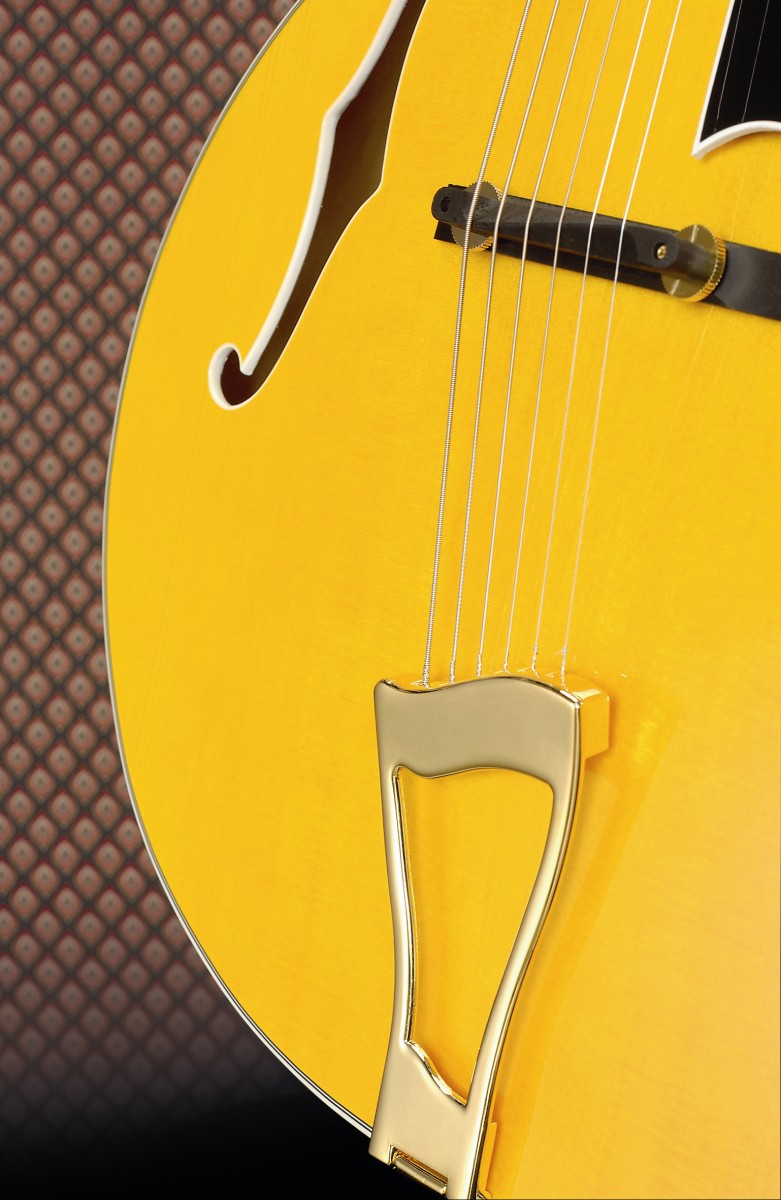MusicRadar Verdict
The rich tones, excellent playability and simple styling will find favour with many players, not just those taking a first step into the archtop world.
Pros
- +
Simplicity. Balanced full bodied tone. Impressive volume.
Cons
- -
Scratchplate needed tightening. First fret position marker.
MusicRadar's got your back
Adam Black is not as exciting a surname as Gibson or Fender, but then he's in a different game. The aim of the Adam Black instrument is not to innovate or revolutionise the guitar world as we know it: his only interest is providing good value, hard-working guitars for the gigging musician.
The JA-10 is part of a trio of archtops (alongside the JA-15 and JA-20) aimed at jazz-leaning players on a budget.
Overview
The JA-10 represents the simplest configuration in the range with a height-adjustable bridge but without pickups. (The JA-15's features include a cutaway and a fingerboard-mounted humbucker,while the JA-20 offers two humbuckers.)
The JA-10's traditional archtop design is derivative of a Stromberg Master 400, or indeed any of the early archtops from European luthiers who upped sticks and emigrated to America in the early 1900s.
It has a reserved appearance, and while the tuners are indeed gold Grovers, they're the more familiar kidney-buttoned kind.
A hinged cast-metal tailpiece, plated in a matching gold, anchors the strings and would certainly benefi t from a little covering of felt on its underside to prevent possible scratches during re-stringing and maintenance.
The neck profile is a playable, shallow C and its maple feels nice and soapy under the fingers, thanks to a uniformly well-applied finish. Binding and fretwork here are examples of the very best of Korean guitar manufacture.
The highly polished crowns of the frets are a dream to play on, and features like the five-ply binding of the fingerboard are indicative of an attention to detail more concerned with areas of direct player contact than cosmetic perfection on the less important areas.
If we really scrutinise the workmanship there are one or two patches on the end of the fingerboard that escaped the golden stain and have been over-zealously sanded, but this is nitpicking on a guitar of this price.
The reason these large-bodied guitars exist is because 1940s big bands made a heck of a lot of noise and, without pickups and amplification to rely on, guitar players needed instruments with bigger bodies and higher bridges that were capable of producing enough volume to be heard.
Despite inheriting these generous proportions, the JA-10 sits well on the knee and isn't bulky under your arm. It is also fitted with a second strap button on the top shoulder for a well-balanced playing experience when standing.
The smart bridge is made from rosewood and is reasonably well fitted apart from a visible gap at the rear. A little time sanding the feet to match the curvature of the top wouldn't go amiss once you get the guitar home.
This simple procedure will increase contact and tonal transfer and is all part and parcel of the initial set-up of an archtop - it's certainly nothing to worry about.
The crest of the bridge saddle is beautifully swept for intonation compensation and, while not 100 per cent accurate when checked against an electronic tuner, it's close enough.
Sounds
The JA-10 is a loud guitar, partly due to its size and partly because of the commendable fitting of 0.11 gauge strings - a lighter gauge would sound and feel wimpy on such a noble guitar. The guitar barks nicely when attacked with a 3mm Jim Dunlop Stubby and treated to some rhythm changes.
It isn't quite as narrow and boxy sounding as you'd want for Django-style playing though. In fact, we found the tone pleasantly surprising - it contains more body and sustain than anticipated.
The honeyed and corky sounding bass is warm and woody, lending chord melody pieces a rich bottom-end.
The overall balance is impressive too with terrific separation and lengthy sustain, even of notes higher up the fingerboard.
We also tried the JA-10 strummed like a flat-top and enjoyed a crisp, clear acoustic tone for our efforts. This clarity of voice would work well when an acoustic sound is needed in the studio that isn't too overbearing, or indeed in a duo setting to provide a foil for a dreadnought, for example.
Guitarist is the longest established UK guitar magazine, offering gear reviews, artist interviews, techniques lessons and loads more, in print, on tablet and on smartphones Digital: http://bit.ly/GuitaristiOS If you love guitars, you'll love Guitarist. Find us in print, on Newsstand for iPad, iPhone and other digital readers
“A synthesizer that is both easy to use and fun to play whilst maintaining a decent degree of programming depth and flexibility”: PWM Mantis review
“I feel like that song had everything we needed to come back with”: Bring Me The Horizon’s Lee Malia on Shadow Moses, its riff and the secrets behind its tone, and why it was the right anthem at the right time
“I said, ‘Are we sure we can write a song about death?’”: The story of Mike + The Mechanics' classic No.1 The Living Years











